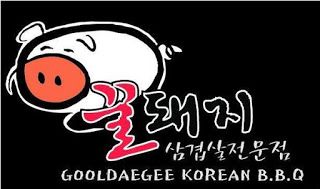In a 36-page opinion, the Board sustained a Section 2(d) opposition to registration of the mark HONEY PIG, in standard form, for restaurant services in view of opposer's prior use of the logo mark shown immediately below, for the same services. Applicant essentially conceded that opposer had priority and did not contest confusingly similarity, but it argued that the coexistence of opposer's mark with a similar registered mark (shown further below) owned by applicant should be dispositive under the thirteenth du Pont factor. LP Global, Inc. v. Seoul Gool Dae Gee, Inc., Opposition No. 91221967 (March 13, 2018) [not precedential] (Opinion by Judge Christopher Larkin).

Applicant pointed to its registration of the mark shown below, for restaurant services [the English equivalent of the Korean "Gooldaegee" is "honey pig"], arguing that its ownership of that registration "presents a unique situation." It cited In re Strategic Partners, Inc., 102 USPQ2d 1397 (TTAB 2012) [TTABlogged here], arguing that the existence of the registration, Opposer's inaction against it, and the coexistence of the parties' marks, outweighed the other duPont factors. In Strategic Partners, the Board reversed a refusal to register the slightly stylized mark ANYWEAR for footwear on the basis of a registration of ANYWEAR BY JOSIE NATORI and design for clothing. The applicant's primary argument was that it owned an incontestable registration of ANYWEARS for footwear.

The Board, however, found Strategic Partners distinguishable. First, it was an ex parte case, and the Board found no prior ruling in which Strategic Partners was applied in an inter partes context. Second, Strategic Partners was not concerned with the absence of actual confusion, which in an inter partes case may be taken into account under the 7th, 8th, and 12th factors. Third, the applied-for and the registered marks here differ far more than the corresponding marks in Strategic Partners.
Applicant's composite mark has been registered for more than eight years and it has coexisted with Opposer's mark for more than 10 years, and both periods are longer than their counterparts in Strategic Partners. Nevertheless, given the differences between Applicant's applied-for and registered marks, and the lack of evidence regarding the extent of use of the registered mark, we find that if, in this inter partes case, the "co-existence of Applicant's prior registration and [Opposer's mark] is a relevant consideration, it does not outweigh the other DuPont factors in this case." USA Warriors Ice Hockey Program, 122 USPQ2d at 1793.
Finally, turning to applicant's claim regarding lack of actual confusion, the Board noted that applicant's restaurant is in Annandale, Virginia, and opposer's in Duluth, Georgia.
Even assuming that the parties' restaurants to some degree "'attract the travelling public'" to their respective locations, America's Best Franchising Inc. v. Abbott, 106 USPQ2d 1540, 1552 (TTAB 2013) (quoting Brennan's, Inc. v. Brennan's Rest., LLC, 360 F.3d 125, 69 USPQ2d 1939, 1944 (2d Cir. 2004)), we find that the "lack of evidence of actual confusion, despite contemporaneous use of the parties' marks for a period of [10] years, is not significant given the circumstances of the parties' respective uses."
Balancing the relevant du Pont factors, the Board found confusion likely and it sustained the opposition.
The content of this article is intended to provide a general guide to the subject matter. Specialist advice should be sought about your specific circumstances.
